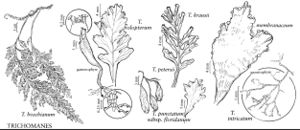Difference between revisions of "Trichomanes intricatum"
Amer. Fern J. 82: 68. 1992.
FNA>Volume Importer |
imported>Volume Importer |
||
| (7 intermediate revisions by 2 users not shown) | |||
| Line 8: | Line 8: | ||
}} | }} | ||
|common_names=Appalachian trichomanes;weft fern | |common_names=Appalachian trichomanes;weft fern | ||
| + | |special_status={{Treatment/ID/Special_status | ||
| + | |code=F | ||
| + | |label=Illustrated | ||
| + | }}{{Treatment/ID/Special_status | ||
| + | |code=E | ||
| + | |label=Endemic | ||
| + | }} | ||
|basionyms= | |basionyms= | ||
|synonyms= | |synonyms= | ||
| Line 17: | Line 24: | ||
}}<!-- | }}<!-- | ||
| − | --><span class="statement" id="st- | + | --><span class="statement" id="st-undefined" data-properties=""><b>Plants </b>on rock, occasionally epiphytic. <b>Sporophytes</b> not known. <b>Gametophytes</b> entirely filamentous, much branched, persistent. <b>Gemmae</b> composed of short filaments of undifferentiated cells.</span><!-- |
-->{{Treatment/Body | -->{{Treatment/Body | ||
| Line 23: | Line 30: | ||
|elevation=150–1800 m | |elevation=150–1800 m | ||
|distribution=Ala.;Conn.;Ga.;Ill.;Ind.;Ky.;Md.;Mass.;N.H.;N.J.;N.Y.;N.C.;Ohio;Pa.;S.C.;Tenn.;Vt.;Va.;W.Va. | |distribution=Ala.;Conn.;Ga.;Ill.;Ind.;Ky.;Md.;Mass.;N.H.;N.J.;N.Y.;N.C.;Ohio;Pa.;S.C.;Tenn.;Vt.;Va.;W.Va. | ||
| − | |discussion=<p>Throughout the eastern uplands of the United States, gametophytes of Trichomanes intricatum form feltlike populations covering up to a square meter or more of rock surface in climatically moderated rock shelters and narrow canyons. Sporophytes are not produced, and reproduction is by gemmae and by perennial gametophyte growth and branching.</p><!-- | + | |discussion=<p>Throughout the eastern uplands of the United States, gametophytes of <i>Trichomanes intricatum</i> form feltlike populations covering up to a square meter or more of rock surface in climatically moderated rock shelters and narrow canyons. Sporophytes are not produced, and reproduction is by gemmae and by perennial gametophyte growth and branching.</p><!-- |
| − | --><p>Filamentous gametophytes of the various Trichomanes species have not been distinguished morphologically. Enzyme electrophoresis, however, has shown the vast majority of independent Trichomanes gametophyte populations, as well as all of those existing beyond the range of sporophytes of T. boschianum and T. petersii, to be T. intricatum. (All populations of gametophytes tested in Arkansas and several populations in the immediate vicinity of sporophytes of T. petersii and T. boschianum in eastern states have enzyme banding patterns identical to one or the other of those species.) The adaptation of T. intricatum to far northern habitats and its inability to produce sporophytes suggest that this is a distinct taxon, possibly derived from a pre-Pleistocene North American species possessing a normal alternation of generations (D. R. Farrar 1985, 1992).</p> | + | --><p>Filamentous gametophytes of the various <i>Trichomanes</i> species have not been distinguished morphologically. Enzyme electrophoresis, however, has shown the vast majority of independent <i>Trichomanes</i> gametophyte populations, as well as all of those existing beyond the range of sporophytes of <i>T. boschianum</i> and <i>T. petersii</i>, to be <i>T. intricatum</i>. (All populations of gametophytes tested in Arkansas and several populations in the immediate vicinity of sporophytes of <i>T. petersii</i> and <i>T. boschianum</i> in eastern states have enzyme banding patterns identical to one or the other of those species.) The adaptation of <i>T. intricatum</i> to far northern habitats and its inability to produce sporophytes suggest that this is a distinct taxon, possibly derived from a pre-Pleistocene North American species possessing a normal alternation of generations (D. R. Farrar 1985, 1992).</p> |
|tables= | |tables= | ||
|references= | |references= | ||
| Line 33: | Line 40: | ||
-->{{#Taxon: | -->{{#Taxon: | ||
name=Trichomanes intricatum | name=Trichomanes intricatum | ||
| − | |||
|authority=Farrar | |authority=Farrar | ||
|rank=species | |rank=species | ||
| Line 46: | Line 52: | ||
|publication title=Amer. Fern J. | |publication title=Amer. Fern J. | ||
|publication year=1992 | |publication year=1992 | ||
| − | |special status= | + | |special status=Illustrated;Endemic |
| − | |source xml=https:// | + | |source xml=https://bitbucket.org/aafc-mbb/fna-data-curation/src/2e0870ddd59836b60bcf96646a41e87ea5a5943a/coarse_grained_fna_xml/V2/V2_159.xml |
|genus=Trichomanes | |genus=Trichomanes | ||
|species=Trichomanes intricatum | |species=Trichomanes intricatum | ||
| − | |||
| − | |||
| − | |||
| − | |||
| − | |||
| − | |||
| − | |||
}}<!-- | }}<!-- | ||
-->[[Category:Treatment]][[Category:Trichomanes]] | -->[[Category:Treatment]][[Category:Trichomanes]] | ||
Latest revision as of 20:21, 5 November 2020
Plants on rock, occasionally epiphytic. Sporophytes not known. Gametophytes entirely filamentous, much branched, persistent. Gemmae composed of short filaments of undifferentiated cells.
Habitat: On noncalcareous rocks in deeply sheltered crevices and grottoes
Elevation: 150–1800 m
Distribution

Ala., Conn., Ga., Ill., Ind., Ky., Md., Mass., N.H., N.J., N.Y., N.C., Ohio, Pa., S.C., Tenn., Vt., Va., W.Va.
Discussion
Throughout the eastern uplands of the United States, gametophytes of Trichomanes intricatum form feltlike populations covering up to a square meter or more of rock surface in climatically moderated rock shelters and narrow canyons. Sporophytes are not produced, and reproduction is by gemmae and by perennial gametophyte growth and branching.
Filamentous gametophytes of the various Trichomanes species have not been distinguished morphologically. Enzyme electrophoresis, however, has shown the vast majority of independent Trichomanes gametophyte populations, as well as all of those existing beyond the range of sporophytes of T. boschianum and T. petersii, to be T. intricatum. (All populations of gametophytes tested in Arkansas and several populations in the immediate vicinity of sporophytes of T. petersii and T. boschianum in eastern states have enzyme banding patterns identical to one or the other of those species.) The adaptation of T. intricatum to far northern habitats and its inability to produce sporophytes suggest that this is a distinct taxon, possibly derived from a pre-Pleistocene North American species possessing a normal alternation of generations (D. R. Farrar 1985, 1992).
Selected References
None.
